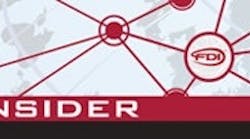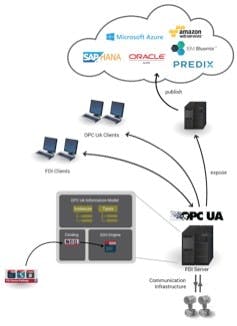IIoT-based Digitization: FDI and OPC UA Drive Open Information Integration
In the era of the Industrial Internet of Things (IIoT) and Industrie 4.0, device and system integration will be paramount to seamless operation. This article concerns the ongoing collaboration between FieldComm Group and the OPC Foundation to advance open information integration and enterprise data exchange. It describes how the Field Device Integration (FDI) and OPC Unified Architecture (OPC UA) standards play a key role in IIoT-based digitization, and in moving field data into the cloud via open platforms such as Microsoft Azure.
Introduction
The IIoT and Industrie 4.0 are everywhere, and they’re redefining manufacturing with an unprecedented level of impact. While the interoperability of IIoT-based devices and systems will no doubt be subject of ongoing discussion over the next few years, there are already well-established standards in industrial and manufacturing environments that can accelerate the shift to outcome-based models.
For example, OPC UA is a platform-independent, service-oriented architecture that provides standard models for secure and reliable information exchange in industrial automation. Developed by the OPC Foundation, it an established standard for integration and interoperability between factory-level devices, supervisory and control systems, manufacturing execution systems (MES), and enterprise applications such as Enterprise Resource Planning (ERP) and Supply Chain Management (SCM). As a vendor-neutral international standard, OPC UA is also published as the IEC 62541 specification.
Challenges of a connected world
[sidebar id =1]With the breadth of the legacy installed base across the global industrial landscape, together with the familiarity of OPC technologies in the manufacturing ecosystem, it stands to reason that OPC UA will accelerate digital transformation through next-generation IIoT applications.
One of the biggest challenges in this endeavor is the sheer number of different devices and applications existing from legacy systems all the way through modern industrial assets and to the future. Automation suppliers are struggling to address the IIoT, and doing so, develop products and solutions enabling customers to have all their data and information in a multi-vendor, multi-platform environment.
IIoT and Industrie 4.0 are all about streamlining manufacturing to the highest degree, but they rely on more than just simple connectivity and communication between disparate equipment assets. These initiatives require a complete understanding of the data from both a syntax and semantic perspective. The volume of data that end-users acquire from the multitude of plant systems is tremendous, and analysts believe it's only going to increase over the coming years due to the number of devices and applications that will soon be connected.
Industrie 4.0 promotes cooperation amongst automation suppliers and their customers to address the demands of asset management, preventative maintenance, and streamlined runtime operation. Organizations like NAMUR, the German chemical industry association, have long focused on asset management and standardized device configuration in a multi-vendor environment. Standardization of devices, including their data and metadata, not only makes configuration easier, but also solves the complex problem of training new plant operators. Training is a significant cost for any manufacturer, and having suppliers agree on data formats makes everyone's life easier.
The Information Technology (IT) and Operations Technology (OT) worlds were traditionally disconnected, which prevented industrial organizations from sharing key information between the two realms. But despite the growing convergence of IT and OT, users really don’t want all the raw data from devices in the OT world to be forced on IT systems. They would rather perform complex analytics on the data at the sensor level to obtain only important information, and then move it into cloud-based applications. The information integration between the IT and OT world depends on reliable high-speed data acquisition systems in the OT world acquiring the data, and then leveraging adaptable configurable analytical software transforming the data into useful information for the IT systems.
There is a current trend whereby intelligent decisions are made about plant assets and process automation with the assistance of enterprise tools. Common tasks such as preventative maintenance and tracking information to know when machinery needs repair can increase efficiency and lower the cost of operations. By having the right data and information, personnel can anticipate problems long before they occur and take appropriate corrective actions to keep the plant up and running.
Collaboration on integration strategies
[sidebar id =2]Today, the industrial automation ecosystem continues to expand through the cooperation of industry organizations that possess deep subject matter experience and knowledge. These organizations are leveraging their know-how and data models using the OPC UA common framework for open collaboration between disciplines in the connected enterprise.
Standards organizations that understand the requirements of IIoT and Industrie 4.0 are working together to promote data interchange across heterogeneous domains and industries – something essential to help enable a fully digital industrial economy. The goal is to standardize on the complex data and information of the respective organizations to provide an infrastructure for secure, reliable information integration and interoperability between previously disconnected devices and applications.
Driven by the ever-increasing demands for process automation data from information systems, a wide range of automation industry stakeholders are beginning to develop their desired architectures for more open interfaces. They seek to break down proprietary architecture barriers between field devices and ultimately cloud-based computing platforms.
In view of this trend, the architects of FDI partnered with the OPC Foundation to include in the design of FDI the OPC UA technology that defines field devices and field device integration in the context of FDI technology. Specifically, the technologies share the same information model that defines the context of field devices in process automation. The goal is to ensure that as systems evolve an open pathway to field device information is assured.
FieldComm Group, which is responsible for ongoing development of FDI technology, has collaborated with the OPC Foundation to provide a solution allowing data and metadata from intelligent device networks to be consumed by generic applications and, more importantly, to have this data converted into information that can be communicated into the IT world and leveraged by cloud-based applications.
According to the OPC Foundation’s President and Executive Director, Thomas J. Burke, there is increased recognition throughout the automation sector of the importance of reliable interoperability and seamless information integration. “Without question, measurement and control technology will keep advancing at a rapid pace, and as such, there is a need to adapt to change and leverage new innovations as quickly as possible,” Burke said. “Having a solid infrastructure and abstract data modeling architecture will enable devices and applications that don't exist today to be seamlessly plugged into existing assets. The value of legacy systems and their integration into the manufacturing applications of the future cannot be overestimated. Our work with FieldComm Group and other standards organizations will ensure that we have an effective strategy for taking data from sensors and other devices, converting it into useful information, and then pushing it into SAP and Microsoft applications and vice-versa, truly realizing bi-directional communication for IT-based applications to push data back down into the OT world.”
Burke continued, “It has been rewarding to collaborate with FieldComm Group on crucial technology initiatives. Our organizations have a common strategy and vision. We understand the value of implementing the best specification and certification processes, and providing technology to our respective communities to bring world-class products to market.”
FieldComm President and CEO Ted Masters has a similar outlook on leveraging the information that comes from intelligent field devices, and believes the FDI standard provides a proven solution allowing end-users to better manage their assets by having standardized device configurations that are independent of the vendors and networking technologies involved with their respective installations.
“FDI meets the demand for a universal, standardized and interoperable technique to comprehensively describe automation components. It is vital for everyday purposes like device configuration, device replacement, maintenance, diagnostics or audit trails – all essential building blocks in a modern field device management system,” Masters said. “At one time, every supplier handled device configuration differently, and if you wanted to make a change, it required a huge amount of engineering overhead, as well as an additional training burden. By having standardization, this issue becomes a lot simpler. No longer are companies required to devote costly engineering hours to do complex conversion between different vendors’ equipment.”
Masters added, “With FDI, the true potential of decentralization, transparency, integration and a central view of all data and functions can be fully realized.”
Creation of a companion specification
Typical use cases for this solution include:
- Interaction between FDI Clients and FDI Servers
- Integration of new communication protocols (i.e., FDI communication servers)
- Access to device information by non-FDI-aware OPC UA Clients, such as archiving tools, maintenance tools, asset management, or ERP systems
FieldComm Group and the OPC Foundation cooperated on a companion specification defining how the information of a field device – described by an Electronic Device Description (EDD) document – is mapped to OPC UA Objects, Methods and Variables. The information model is primarily based on the OPC UA for Devices specification; in fact, most of the OPC UA for Devices model has been driven by FDI requirements.
FieldComm Group’s Director of Integration Technology, Achim Laubenstein, stated, “FDI technology manages information from intelligent field devices during their entire lifecycle – from configuration, commissioning and diagnostics to calibration, making one-off solutions for different devices obsolete. The standardization of field device information facilitates the development of native OPC UA applications that support the OPC UA device information model.”
In addition to the device model, FDI defines how communication topologies of the automation system, representing the entire communication infrastructure, should be represented in an OPC UA Address Space. The comprehensive set of services provided by OPC UA enables the “how” of system integration.
The FDI communication server information model is used for integration of non-native field protocols, and as such, supports the integration of communication with devices in heterogeneous, hierarchical networks, as well as the use of any communication hardware.
Burke commented on the collaborative development process: “The hardest part of the work on the OPC UA information model was getting agreement and standardization on the data and metadata across different vendors’ devices,” Burke said. “FieldComm Group has been doing this for years, and provides a very rich data and information model that suppliers incorporate directly into their FOUNDATION Fieldbus, HART and WirelessHART products.”
Most recently, FieldComm Group and the OPC Foundation have collaborated on an OPC UA Server interface to the FDI Server. Major global automation suppliers that are active in both organizations are driving this effort.
The OPC UA architecture is built into Industrie 4.0, and there are multiple test beds under development within the industrial Internet community. One of the major test beds will show how OPC UA is directly incorporated into the FDI Server to provide seamless information integration into the IT world via the OPC UA interfaces.
Cloud-based solution for plant data
FieldComm Group’s Integration Working Group is enhancing the FDI/OPC UA information model specification to provide semantics for machine-readable information. This specification will allow cloud-based applications to process field device information without extra configuration.
Industrial organizations will now gain seamless information integration into computing platforms like the Microsoft Azure cloud by leveraging the OPC UA companion specification. This capability will significantly enhance compatibility and interoperability in the new digital world, said Erich Barnstedt, principle software engineering lead at Microsoft.
“Microsoft is the only technology provider with the ability to transform the OPC UA data model and offer it in the cloud,” Barnstedt said. “This is achieved by enabling both OPC UA Client/Server and Publisher/Subscriber connections to the cloud. Applications that used to run on-premise can now run globally in the cloud without having to change the interface. By mapping FieldComm Group’s data model to OPC UA, it is now possible to use robust services available for OPC UA through the Azure cloud.”
Microsoft’s Azure IoT Suite is intended to connect devices and other assets; capture the diverse and voluminous data they generate; integrate and orchestrate the flow of that data; and manage, analyze and present it as usable information to people who need to make better decisions. There is a cloud bridge, which is essentially a software component acting as an OPC Client towards one or several OPC UA Servers and relaying data to a cloud-based messaging gateway.
Thanks to the latest technology developments, enterprise intelligence can be deployed to reinforce the use of data and establish analytics-based decisions. Such digital transformation involves reengineering workflows around enhanced and consistent information, and changing data management paradigms.
Outlook for the future
FieldComm Group and the OPC Foundation are committed to developing complete infrastructures and solutions for seamless information integration in industrial automation applications. Both organizations recognize they must provide standards that help solve real-world problems and create new opportunities. This includes ongoing enhancements to the FDI standard, and potentially incorporating other organizations’ networking technologies into a common integration architecture.
Conclusion
Proprietary solutions in industrial automation are quickly becoming a thing of the past. The engineers and end-users of today – primarily driven by their experiences with consumer electronics – no longer will be satisfied with products from different vendors not interoperating together in a seamless manner. This expectation now requires multi-vendor and multi-platform information integration from the sensor to the cloud. The days of the IT and OT worlds not communicating are also waning, with both sides seeking to convert data and metadata from plant assets into meaningful information. The activities of FieldComm Group working with the OPC Foundation will help make this a reality.
For more information, please visit the FDI Technology Overview page on the FieldComm Group website.






